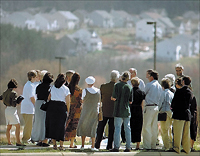|
by Pat Joseph
The Sierra Club is a tough grader.
 In a report entitled "Clearing the Air with Transit Spending," the Club evaluated the 50 largest metropolitan areas in the United States based on two criteria: smog from cars and expenditures on public transportation. Thirty-one of those cities flunked and the rest fared only slightly better: 13 received Ds, six got Cs, two managed Bs, and there wasn't a single A in the bunch. In a report entitled "Clearing the Air with Transit Spending," the Club evaluated the 50 largest metropolitan areas in the United States based on two criteria: smog from cars and expenditures on public transportation. Thirty-one of those cities flunked and the rest fared only slightly better: 13 received Ds, six got Cs, two managed Bs, and there wasn't a single A in the bunch.
The results may sound dismal, but so are the facts. According to the report, the average American driver spends 443 hours per year -- more than 10 work weeks -- stuck in traffic. While cars may have gotten cleaner, smog has gotten worse, thanks in part to an infatuation with SUVs and the fact that sprawl forces us to drive more. Perhaps most surprising of all is the finding that even cities with declining populations -- places like Detroit and Cleveland -- are in fact growing in area, gobbling up surrounding open space.
 Despite the bleak assessment, Tim Frank, chair of the Club's Challenge to Sprawl Committee, sees the report, which generated nearly a hundred stories in the media, as a definite highlight of 2001. "It did what we wanted it to do," he says. "It drew a link in people's minds between how the government spends money on transportation - something they can affect - and how their environments and communities function. That's positive." Despite the bleak assessment, Tim Frank, chair of the Club's Challenge to Sprawl Committee, sees the report, which generated nearly a hundred stories in the media, as a definite highlight of 2001. "It did what we wanted it to do," he says. "It drew a link in people's minds between how the government spends money on transportation - something they can affect - and how their environments and communities function. That's positive."
The Sierra Club wasn't the only group calling attention to the issue. Doctors from the Centers for Disease Control and Prevention and the American Lung Association warned of myriad health risks - everything from asthma to obesity - associated with sprawling development. And in another report, the U.S. Forest Service cited sprawl as the number one threat to forests in the South. Melody Flowers of the Sprawl Campaign sees this as part of an encouraging trend. "It's good to see that even non-environmental organizations are addressing the issue and confirming what we've been saying all along."
There are, thankfully, other bright spots on the sprawl front as well. For one thing, public transportation ridership has continued to grow, outpacing increases in car travel. For another, the issue has become a winner at the ballot box, with anti-sprawl candidates taking gubernatorial elections in Virginia and New Jersey. In Minnesota, where sprawl devours 65 acres of open space and farmland each day, environmentalists welcomed the election of smart-growth candidate R.T. Rybak as mayor of Minneapolis. Rybak said subsequently that the Sierra Club's endorsement was the turning point of his campaign.
In other places around the country, the fight is being waged in the courtroom. In Utah, for example, the Sierra Club won an injunction on construction of the 125-mile-long Legacy Parkway outside Salt Lake City. Derided as a "legacy of concrete," the highway project would pave over wetlands while contributing to sprawl. In California, the Sierra Club joined with trade unions to defeat an executive order that banned the use of Project Labor Agreements in federally funded construction projects, including the Richmond Transit Village, a housing development that will provide increased transportation options, limit suburban sprawl and decrease air pollution.
Project Labor Agreements, which the Sierra Club supports, guarantee that developers won't cut costs by using underqualified workers. Frank cites the successful cleanup of Boston Harbor as one of the best examples of Project Labor Agreements.
This kind of coalition building may be the future of the smart-growth movement, says Frank, stressing that the issue unites labor organizations, affordable housing advocates, minority interests and enlightened business leaders. "Ideally, even developers will come on board. Instead of always standing in front of the bulldozers, I'd like to see us getting behind them, and support developments that are good for the environment."
In fact, the Sprawl Committee looks forward to spending more time fighting for good projects. "It's a wonderful turning point," says Frank. "We're looking to support affordable housing in job-rich areas, and redevelop some of the messed up infrastructure we inherited. That's the kind of 'man bites dog' story that I'd really like to see."
New Year's Resolution: Although the federal transportation bill will not be reauthorized until sometime in 2003, the Sprawl Campaign will be focused on making sure that transit gets its fair share of the $250 billion pie.
More on Sprawl.
Photo captions: When Neighbors Sprawl: A regional Voters to Stop Sprawl campaign organized with help from the Battlefields Group in Fredericksburg, Va., includes this gathering in the sprawling Lee's Hill area. The campaign helps elect a majority of "slow-growth" candidates to the Stafford County Board.
Up to Top
|